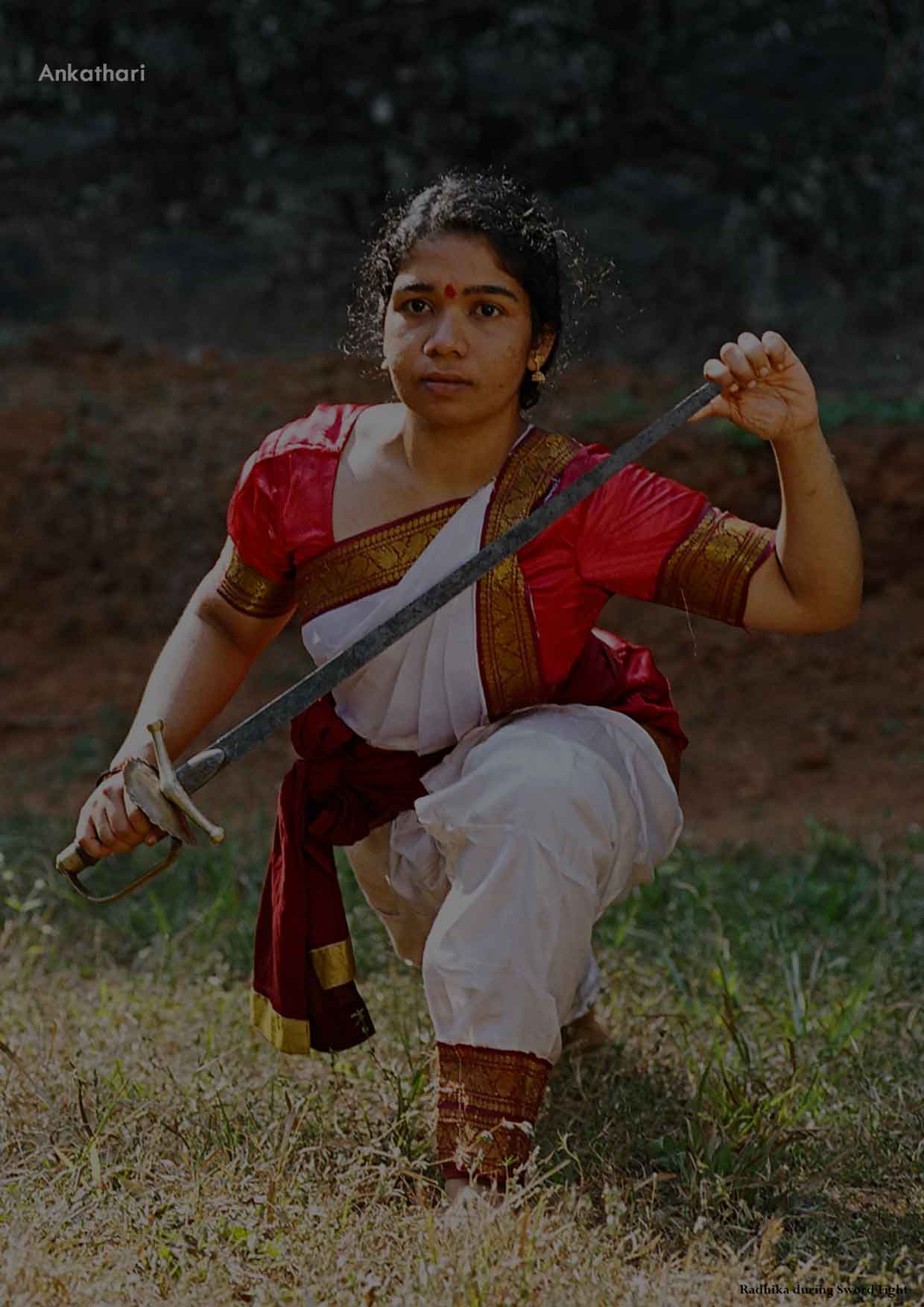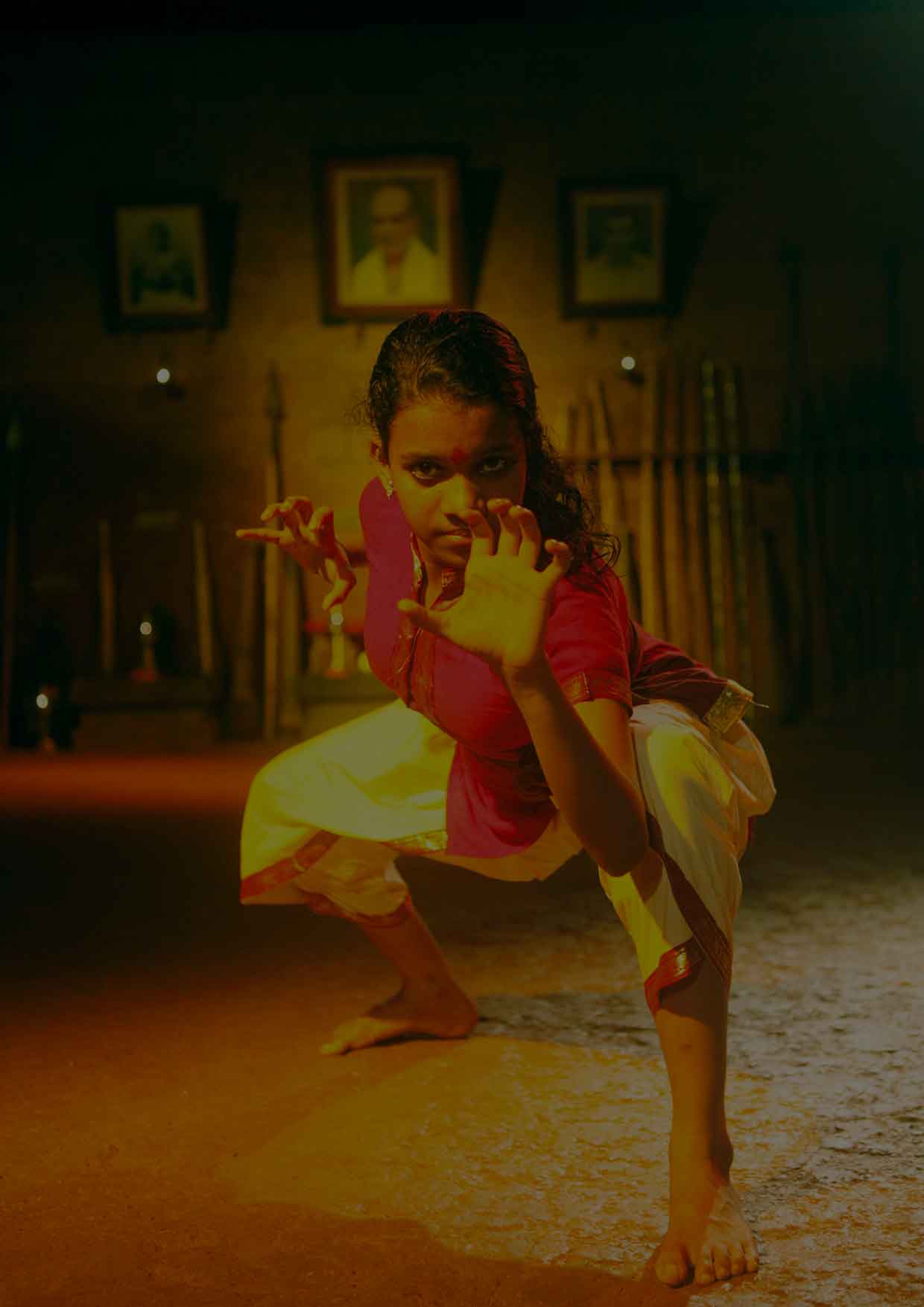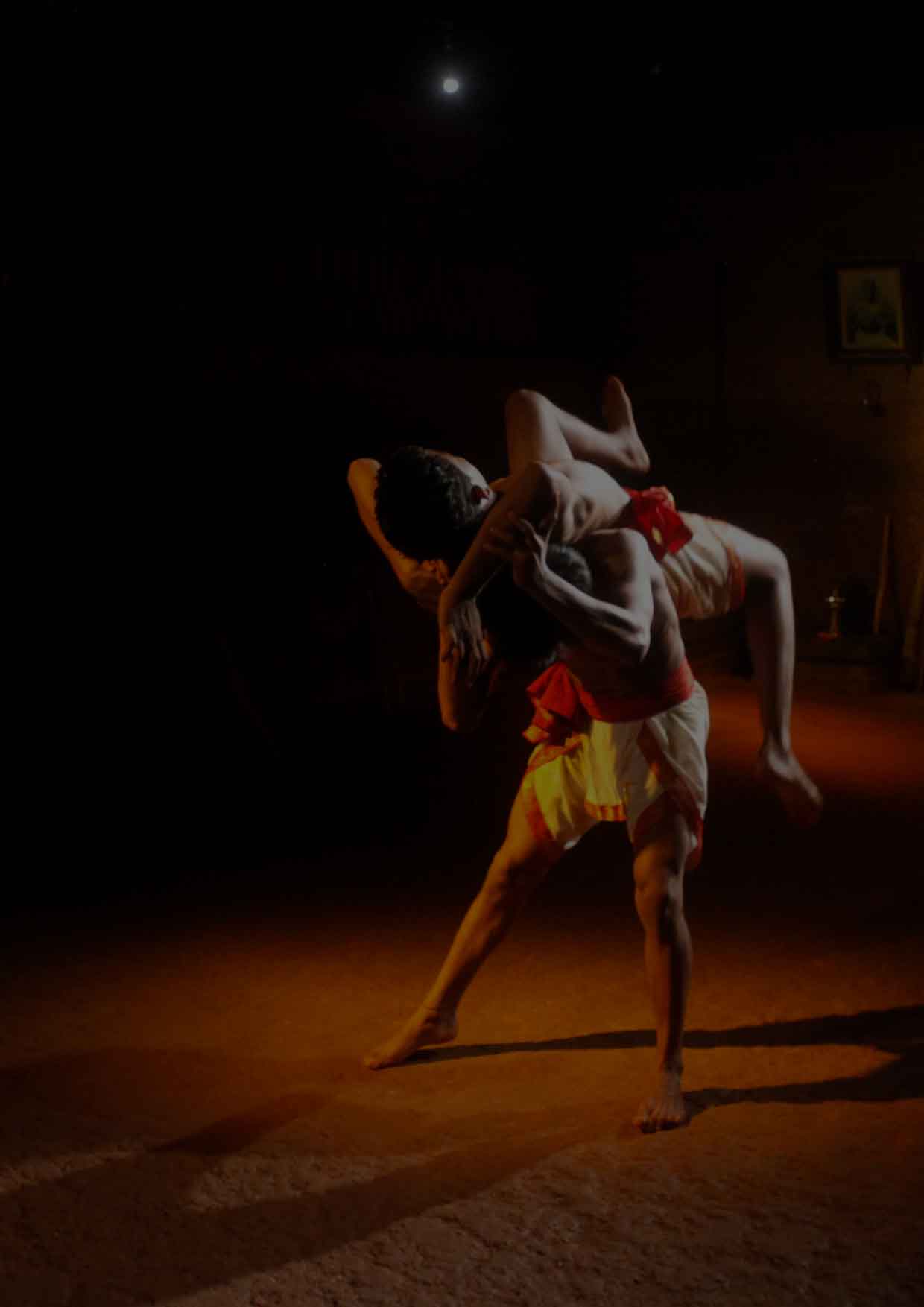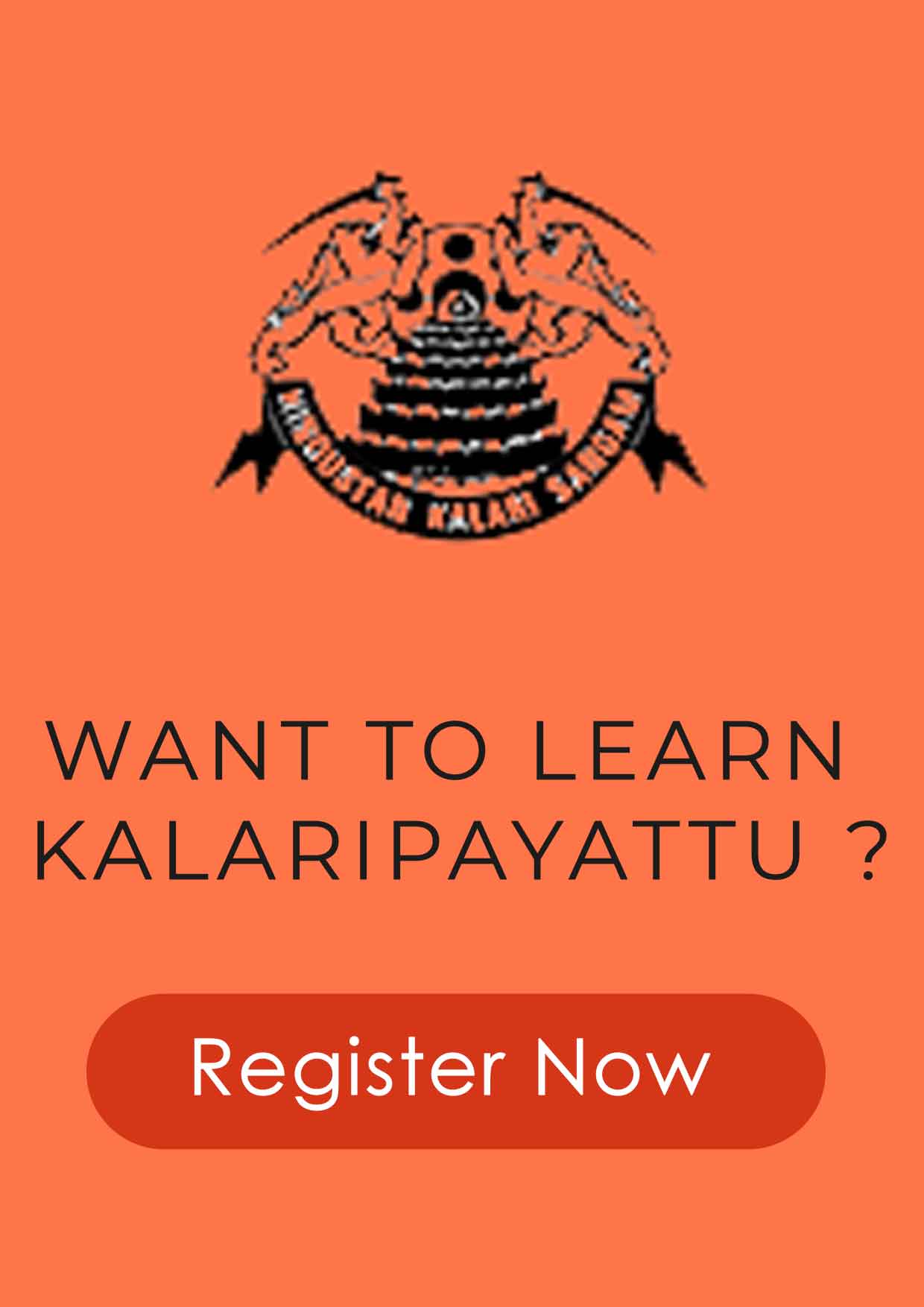Dhanurveda
The word dhanu means a bow (the comprehensive meaning suggests a bow and an arrow) and the word veda denotes the scientific source. Dhanurveda is explained as Upaveda (subversion) of Yajurveda, by which the soldiers can become proficient in the warfare techniques, combat methodologies and the science of weaponry. The use of bows and arrows is considered to be the superior mode of the combat technology when compared to the other forms of a combat.
The system of training with a bow and an arrow, commonly known as the Classical Indian Archery, is considered to constitute the integral part of the Kalarippayat tradition. In the course of time, this particular system of practice disappeared from the traditional schools due to various known and unknown reasons.

Hendrik Wiethase, a German scholar along with the faculties of Hindustan Kalari Sangam, has put notable efforts in reviving this combat form through various ways. Forty years of significant effort resulted in forming a training methodology in the area of classical Indian archery. Besides the formation of the training methodology, there exist many treatises published in this field, too.
Under the guidance of dhanurganaka, Hendrik Wiethase, Hindustan Kalari Sangam imparts training sessions on the Classical Indian Archery (CIA) during various time periods.
Classical Indian Archery based on the Dhanurveda
The Dhanurveda is one of the four Upa-vedas (secondary Vedas), these being Ayurveda (the knowledge of live), Dhanurveda (the knowledge of war skills, Dhanur means bow), Gandharvaveda (the knowledge of music and dance) und Stapatyaveda (the knowledge of architecture). In the ancient writings of India again and again the Dhanurveda is mentioned and cited.
The main difference between the Classical Indian Archery following the Dhanurveda and all the known traditional arts of bow shooting is the variety of bows and their different usages, arrows, targets and sthanas (postures). These manifold usages are more developed in the Dhanurveda than in other type of archery and the student is encouraged not only to learn them all but to choose the one through which he will evolve his own personality. In the course of his learning the student will discover the very aspects that correspond with his hidden potentials and concentrate on them. Thus the art of archery becomes the tool of the enhancement of his character. He will also be challenged by the permanent need to deal with success and failure.
In today’s India, classical Indian martial arts can only be found in the Kalari-tradition in Kerala and in the Thang-tha in Manipur.
If archery today is not necessary – neither in hunting nor in warfare – why should someone learn this ancient martial art? Why should someone spend time training these skills? Archery is not only a physical but also a mental training. It develops social and personal consciousness, self-respect, concentration and contemplation.
The archer is permanently preoccupied with success and failure. A good teacher will not only convey a good technique, but also help his student to emotionally deal with this specific problem. In this way the mindful student can mature and become his own attentive teacher.
The guiding principles of archery are equally valuable in all regions of live and teach us the following qualities:
The better I am prepared – the larger my success. I do not always need to hit the mark. Nobody will always hit the mark. I am the sum of different potentials and qualties and subjected to different circumstances. Wholeheartedness is the prerequisite of lasting success. My personal success is lasting, if I am willing to question myself and accept hinderances. Not only I determine the course of things. The lightness of relaxation is my true intention.
The trainee who observed a fast
and wearing only a deerskin,
will pray for the bow from his preceptor
folding his hands.
Then following the utterances of Shiva, the preceptor
should sanctify the limbs of his disciple,
putting his hands on them,
by uttering appropriate mantras
and should perform other rituals
for removing the obstacles and sins of his disciple.
Lord Sankara will be ritually imagined to have been placed upon the top-knot of the disciple’s hair at the crown, Lord Kesava will be so placed on the joint of the two arms, Brahma in the navel and Ganesa on his thighs.
Om hom sikha sthane sankaraya namah
Om hom vahvoh kesavaya namah,
Om hom nabhimadhye brahmane namah,
Om hom janghayor ganapataye namah
The master should offer bow and arrows to the student, which are fit to be used by a human being
and the arrows should be sanctified with mantras
and the teacher would pass the mantra from one arrow to the other according to the rules of Vedas.
The Matsari: If the tip of the forefinger is placed squarely on the nail of the thumb finger, then such a release is known by the name Matsari. Such a release is used to pierce a fine or thin target known as Citra.
The Arrow Belt : In shooting Dhanurvidya the arrows are not hanging in a cooker around the
In ancient times the archers when in battle were riding in a war-chariot and carried the maximum of arrows with them. Sometimes they were guided by another warrior with a shield, to protect him, which shows the importance of an archer these days.
The weather being warm the archer wears the traditional Kalari garment. Women wear a wrapped top, similar to the wrapped trousers the material being densely woven cotton. This sort of garment allows for maximum freedom of movement with all Sthanas. For shooting with the right hand, the ends of the arrows must point to the left side of the archer and to the left, if it is shot with the left hand. If sharp arrowheads are used, a special belt with a leather pocket inside it is used to protect the archer. The belt has to be worn tight and firm. Students wear a belt of cotton, which is tied three or four times around the hips.
A master or one who shoots with sharp arrows, wears a leather belt, which is covered with silk or cotton.
Breathing and Shooting: For breathing properly one should draw the breath, hold the nose, shut the eyes and after a while release the breath with “OM”.
Ayurveda prescribes breathing, the Samāna, as a matter with four parts: Prāna: inhale, Udāna: uphale, Apāna: down breath, Vyāna: between breath. Vyāna is considered as the most powerful and less irritating moment as it is between apāna and prāna. In this moment we feel the benefit of the breathing without us willing it. The breathing in between allows for spiritual experiences to occur. So each student must be taught prānayama and then breath as constantly, nourishing and powerfully as the ocean. Prānajama is supposed to become a part of his live, as beautiful shooting and healthy, pure thinking. When we become aware of our breathing we also become aware of the power of life and now we can proceed to the cleansing of our mind which after all is the basis of a wholesome way of life.
Breathing in, holding the breath and pushing it out while releasing the arrow is bad for shooting. A dam keeps the power of a stream behind a wall. If this breaks, the power leaves without control and guidance. Besides, it can lead to breathing problems if we hold the breath until ‚it’ shoots, i.e. the proper moment for releasing has occurred. Therefore: after having made Pranayama part of ones life one can forget about it. The powerful stream of our breath will flow on its own account and shooting will happen effortlessly as part of it.
Visakha sthana
is the first posture, which has to be learned perfectly, because it contains all the important properties of shooting in the easiest posture.
The student stands with his feet parallel about one and a half feet apart from each other. His knees are not straight and he is stabilized perfectly. His left shoulder points to the target. He holds his bow with his left hand. His arm is bent and the hand which holds the bow is at the level of his umbilicus.
Visakha sthana
is the first posture, which has to be learned perfectly, because it contains all the important properties of shooting in the easiest posture.
The student stands with his feet parallel about one and a half feet apart from each other. His knees are not straight and he is stabilized perfectly. His left shoulder points to the target. He holds his bow with his left hand. His arm is bent and the hand which holds the bow is at the level of his umbilicus.
Nocking version for beginners:
He looks down to his bow, takes an arrow with his middle finger, pointing finger and thumb underneath the feathers and puts the nock on the right place on the string in one smooth move, without correcting it. Then he looks at the target.>
Advanced nocking version:
He looks to the target, takes an arrow at the nock and puts the arrow on the right place on the string in one smooth move, without correcting it.
Pulling:
The left arm pushes the bow towards the target, while the right arm pulls the string with the arrow on it upwards to the cheek. This has to be done in one smooth move and the two hands have to reach their final position in the same moment. The bow arm is not completely straightened but a little bent, so the string if released must not touch the archers arm. The hand does not squeeze the bow, but its fingers are relaxed.
The arrow-hand pulls the string close to the edge of the mouth, so the string is as much as possible horizontal to the right eye. The fingers do not twist the string. Before the release the two hands have to stay completely still. The arrow does not move at all.
The release:
The fingers let the string go by just relaxing. The arm is not moving at all and the hand stays in her position. It stays there for a short time. Moving the arm or the hand during the release is very bad for a precisely shot. This posture has to be learned with the left and the right hand. This posture is as easily possible with a long arrow and with a thumb ring or the shooting tablet. Therefore we shoot with full draw, by pulling the string underneath our ear. Aiming in full draw is different to the aiming by pulling the string to the cheek and has to be trained separately.
What do we regard as being beautiful? An unspoilt spot of nature, a lake motionless like a mirror, anything which is true to itself, peaceful and undisturbed. We do not see any irregularity, nothing seems false or not at its right place and time, nevertheless, every part it contains has its own purpose, function and place inside the system.
The weapons, we are training with, are capable of killing a man or an animal within seconds. We know this and are always aware of this. Always bearing this in mind will lead a good student to beautiful shooting, in which every action and thought is flowing in a beautiful circle.
How can perfection in moving be reached? By training all the single parts, which lead to one entirety. The posture we use is filled with a purpose, everyone should know and demonstrate. To stand erected means erected inside and outside. When shooting from a warrior’s posture, we need to feel the worrier inside of us. Something the others will see and feel.
“My bow and arrows are chosen, depending on the distance and the target, which I shoot at. I know how to shoot. My bow is bent right and without effort. I take the arrows, I want to shoot. I show humbleness towards the target and take the first position related to the sthana. I choose the first arrow and put it on the string, in one flow to the position from which my shooting will be executed, shoot when time is right and return to the first position. This I repeat, until the last arrow is shot. I show humbleness towards the target. I fetch my arrows. All the single parts of my shooting flow in one circle without visible strain in total composure.”
We reduce our intentions to the minimum to reach the maximum. We only take the arrow, we only put it on the string, we only bend the bow, we only release the arrow, we only hit the target and we only do it again and again…
Until a series of beautiful shots can be done, one learns to execute faultlessly each single step without hurry or hesitance. At the end, one successful part will lead together with the others like pearls on a string, to one whole acting in harmony, as in live the line of righteous acts lead to a successful whole.
Shooting without shooting means, to weave the wisdom one will earn, after he has reached the high level of a Master into his entire being. The attributes, which lead to beautiful shooting, will lead to beautiful behavior.
One, who has the knowledge of using a deadly weapon in perfection, is not in need to show his abilities in impropriate situations. This is meant, when in ancient writing it is said: “When there is a high skilled archer in the village, the lion will avoid it.”
One, who is calm and aware in his shooting, can be so in his daily live, knowing the right time will come for everything and if you are prepared, you will earn the benefits.
One, who is a good Master, knows when the right time has come to help his disciple making his next step. He will trust the power of the love and care he gives to him.
During the process of Dhanurvidya we learn to clean our mind from disturbing thoughts until it is empty and there is nothing, but awareness and purification can happen. The purified mind turns from an intentional disposition to an unintentional one.
This is the white flame, the end and the beginning of the circle, the Vyāna.




 by Irizz Technology
by Irizz Technology